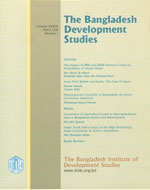 BDS Current Issue Volume XXXIV, March 2011, Number 1
BDS Current Issue Volume XXXIV, March 2011, Number 1
Initial Trade Policy Focus of the High Performing Asian Economies: A Critical Assessment
Author: Mia Mahmudur Rahim
Abstract |  Download Attachment
Download Attachment
It is generally agreed that national trade policies of Singapore, South Korea, Taiwan and Hong Kong played an important role behind the success of the High Performing Asian Economies (HPAEs). These countries exercised different policies with different implementation strategies at the initial stages of their economic success but resulted almost the same success. Thus, on the one hand, they followed some different ways following their specific needs and, on the other hand, maintained the same underlying principles for their national trade policies. They were although pragmatic in their economic policy focus, they did not adopt any common model or blueprint policy rather their strategies were followed by their specific strength, weakness and goals.
Conversion of Agricultural Land to Non-agricultural Uses in Bangladesh:Extent and Determinants
Author: Md Abul Quasem
Abstract |  Download Attachment
Download Attachment
Bangladesh is a land scarce country where per capita cultivated land is only 12.5 decimals. It is claimed that every year about one per cent of farm land in the country is being converted to non-agricultural uses (such high rate of conversion will not only hamper agricultural production but will have adverse impact on food security). The present study estimates the rate of land conversion and consequent loss of agricultural production of the country besides determining the factors affecting such conversion. The study is based mainly on field survey covering 24 villages from six divisions of the country Annual Conversion of farm land is estimated to be 0.56 per cent and the country’s loss of rice production is also estimated to be between 0.86 and 1.16 per cent. The converted land is predominantly used for construction of houses, followed by roads and establishment of business enterprises. The land poor records higher rate of land conversion. The two principal determining factors for such conversion are found to be land ownership size of a household and the non-agricultural occupation of household heads. To arrest the existing rate of land conversion, the surveyed households suggest for more profitable rates of return from farming activities besides imposing special sales tax for conversion of farm land.
Money-Income Causality in Bangladesh An Error Correction Approach
Author: Mohammad Amzad Hossain
Abstract |  Download Attachment
Download Attachment
The causal relationship between money and income remains a contentious and lively issue in the literature. Even though the literature on this issue is voluminous, however, for Bangladesh it is quite nascent. A few earlier studies suffer from methodological deficiency as they did not take into consider the time series properties of the variables. The objective of this paper is to look on the causality between money and income in Bangladesh. The paper differs from the earlier ones regarding data used and econometric techniques applied. The main contribution of the paper is to address the issue of short run dynamics of the money income relationship within a long run relationship. The empirical results show that money supply and income are cointegrated, implying that there is stable long run relationship between them. The estimated error correction model shows that there is bidirectional causality between money and income, implying that monetary policy should be undertaken to realise the basic macroeconomic goals of achieving higher level of output.
Asset Price Bubble and Banks: The Case of Japan
Author: Monzur Hossain & Farhana Rafiq
Abstract |  Download Attachment
Download Attachment
This paper analyses the behaviour of the Japanese banks at the outset of the asset price bubble in the late 1980s. The paper argues that with the advent of financial deregulations, the declining trend of profitability forced the banks to exhibit speculative behaviour during the asset price bubble period (mid-1980s) to increase short term profit. This has ultimately led to the banking crisis after the burst of the bubble in 1989. Our empirical results support this argument. The paper also attempts to provide a comprehensive description of a number of interrelated structural changes in the financial system of Japan during 1977-2003 that opens up the domain of possibility for rethinking the issues related to change in policies. The case of Japan in the context of the rise and burst of the asset price bubble and subsequent banking crisis could be instructive for many countries including Bangladesh that are facing the asset price bubble situation. Japanese experience suggests that monetary policy should respond to asset bubbles in a cautious and moderate manner in order to avoid economic distortions. The lessons that can be learned from the Japanese experience are: (i) central bank’s role to burst bubbles must depend on the degree of efficiency of the financial sector, and (ii) the speed to burst the bubble must be based on the overall economic situation.
The Impact of 1998 and 2008 Financial Crises on Profitability of Islamic Banks
Author: Nor Hayati Bt Ahmad & Mohamad Akbar Noor Bin Mohamad Noor
Abstract |  Download Attachment
Download Attachment
The paper investigates the profitability of 78 Islamic banks in 25 countries for the period of 1992-2009. The Fixed Effect Model (FEM) used to analyse profitability shows that profit efficiency is positive and statistically significant with operating expenses against asset, equity, high income countries and non-performing loans against total loans. Interestingly, the empirical results show that more profitable banks are those that have higher operating expenses against asset, more equity against asset and concentrated at high income countries demonstrating close relationship between monetary factors in determining Islamic banks profitability. The findings for 1998 Asian Financial Crisis and 2008 Global Financial Crisis are negative and imply that Islamic banks’ profitability has not been impacted during Asian and Global Financial crises.
